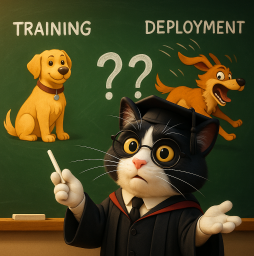
AI Safety IV: Sparks of Misalignment
This is the last, fourth post in our series...
This is the last, fourth post in our series on AI safety (first, second, third). We have discussed the main definitions of the field, introduced goodharting as a key component of possible misalignment, and talked about interpretability as a possible constructive way forward. Today, we will consider a few examples of AI system behaviours that are, to say the least, highly disturbing. We will see how LLMs can turn into sleeper agents, fake alignment to avoid retraining, and earn millions of dollars on cryptocurrency markets. Let the sparks of misalignment fly!
In the third post on AI safety (first, second), we turn to interpretability, which has emerged as one of the most promising directions in AI safety research, offering some real hope for understanding the “giant inscrutable matrices” of modern AI models. We will discuss the recent progress from early feature visualization to cutting-edge sparse autoencoders that can isolate individual concepts like “unsafe code”, “sycophancy”, or “the Golden Gate bridge” within frontier models. We also move from interpreting individual neurons to mapping entire computational circuits and even show how LLMs can spontaneously develop RL algorithms. In my opinion, recent breakthroughs in interpretability represent genuine advances towards the existentially important goal of building safe AI systems.
Although deep learning is a very new branch of computer science, foundations of neural networks have been in place since the 1950s: we have been training directed graphs composed of artificial neurons (perceptrons), and each individual neuron has always looked like a linear combination of inputs followed by a nonlinear function like ReLU. In April 2024, a new paradigm emerged: Kolmogorov-Arnold networks (KAN) work on a different theoretical basis and promise not only a better fit for the data but also much improved interpretability and an ability to cross over to symbolic discoveries. In this post, we discuss this paradigm, what the main differences are, and where KAN can get us right now.
One of the most striking AI advances this spring was OpenAI’s Sora, a video generation model that sets new standards for video consistency and diversity. Interestingly, the official report on Sora is titled “Video generation models as world simulators”. It notes that Sora has emerging simulation capabilities and is on a “promising path towards the development of capable simulators of the physical and digital world”. Today, we discuss world models in modern artificial intelligence: what they are, how they have progressed over the last few years, and where they may go in the future.
This is the last post in the “Generative AI” series. Today, we look into the future and discuss where the current trends take us, what dangers might artificial general intelligence (AGI) hold for us, and whether we are ready for these dangers (spoiler: not at all). I will present the case for AGI doomers and discuss the main arguments, but please keep in mind that in this post, everything is mostly speculation (although there actually are attempts to put this speculation on firm mathematical ground).
Today, we continue our discussion of generative AI, a direction that keeps transforming many different industries. Last time, we reviewed the difference between continuous and discrete latent spaces, and how the VQ-VAE architecture (based on variational autoencoders that we discussed before) manages to learn a discrete latent space, a codebook that Today, we will put this idea into further practice with our first real text-to-image model, OpenAI’s DALL-E.
Synthesis AI CEO and Founder Yashar Behzadi recently sat down for an Ask Me Anything with our friends at Inside AI. The discussion was wide-ranging, touching on what’s next for generative AI, how synthetic data is generated and used, overcoming model bias, and the ethics of AI systems. If you’re tinkering with generative AI and need representative synthetic human data for developing ML models ethically, we’d love to talk — contact us any time.
Previously on this blog, we have discussed the data problem: why machine learning may be hitting a wall, how one-shot and zero-shot learning can help, how come reinforcement learning does not need data at all, and how unlabeled datasets can inform even supervised learning tasks. Today, we begin discussing our main topic: synthetic data. Let us start from the very beginning: how synthetic data was done in the early days of computer vision…